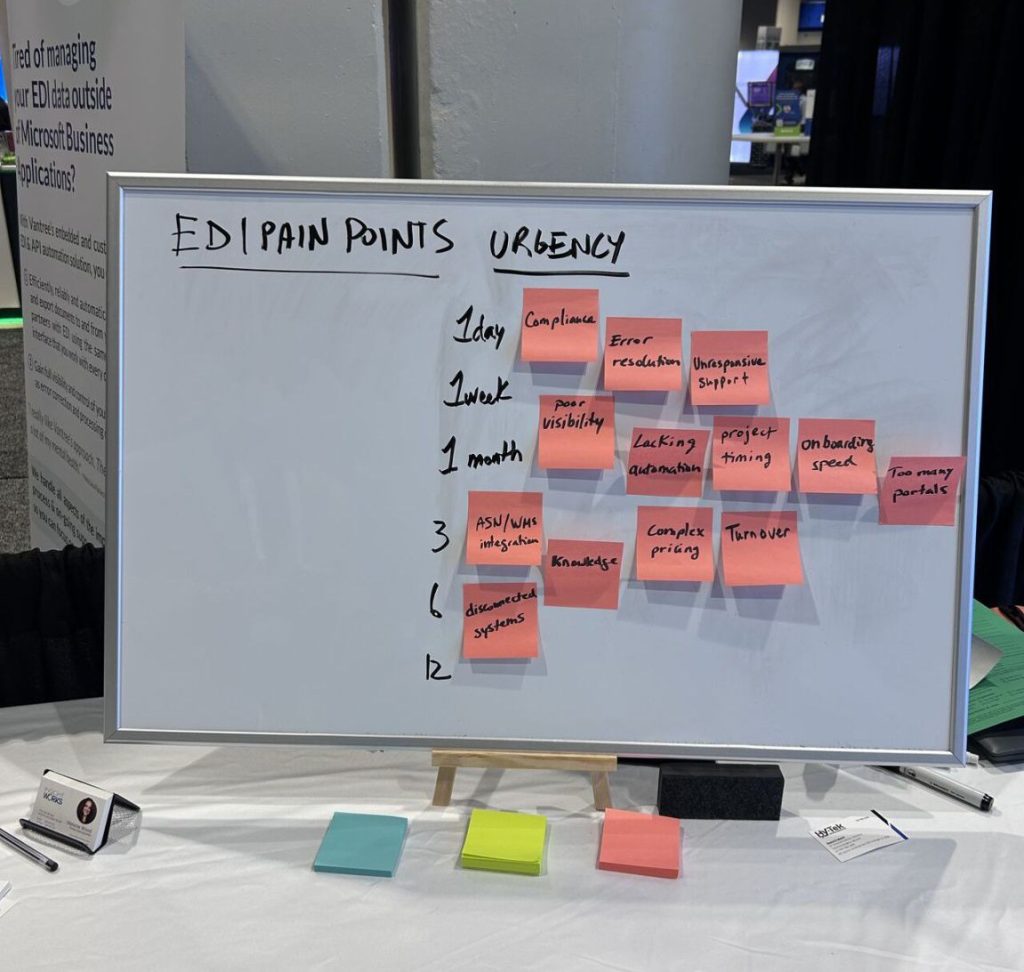On October 21st, 2025 at #MySummitNA, we gathered around our Booth 601 for what turned out to be one of the most candid and eye-opening sessions of the week — our EDI Pain Points Meetup.
Every participant came from the manufacturing and distribution space, each with different levels of experience, but one thing united them: they were all leaders who had inherited their current EDI solutions — and the problems that came with them.
Some were just starting to explore the fine print of their existing contracts and processes, while others were trying to make sense of legacy systems that had been in place for years. The group quickly realized that many of their challenges weren’t unique. They were systemic.

Together, we listed the biggest pain points and prioritized them by urgency — what needs to be addressed in 1 day, 1 week, 1 month, 3 months, 6 months, and 12 months.
Here’s what surfaced to the top:
- Trading Partner Compliance
- Error Resolution
- Unresponsive Support & Poor Visibility
- Manual Data Entry / Lack of Automation
- Project Timing & Slow Onboarding
- Too Many Portals & Interfaces
- Lacking EDI Knowledge
- Complex Pricing
- Staff Turnover
- Disconnected Systems
As the discussion deepened, one participant shared a story that hit everyone hard.
She once worked for an organization that lost over $1 million in chargebacks in a single month due to EDI errors and compliance issues. It was a sobering reminder of just how high the stakes can be when systems don’t talk — and teams can’t see what’s really happening.
Others shared smaller-scale stories — but the message was the same: these issues have massive financial, operational, and reputational consequences. They can’t be ignored or treated as “just another IT problem.”
When we reached the topic of poor visibility, the room grew quieter. One participant summed it up perfectly:
“If you can’t see anything, you can’t solve anything.”
That insight sparked a powerful dialogue about the importance of clear infrastructure and centralized data pipelines — the ability to see information flow in and out of your business seamlessly. Without it, troubleshooting becomes guesswork, and teams lose confidence in their systems and each other.

The Hidden Costs of Manual Work and Limited Systems
When the topic turned to manual data entry, one participant described a process that stopped everyone in their tracks.
To receive orders from a complex trading partner, his team had to first receive them as PDFs, manually key them into Excel, and then enter them into their ERP system. The entire process was repetitive, slow, and prone to human error. He was stunned by how inefficient it was — and how risky.
On the other end of the spectrum, another participant shared how automation had been slowed down by system limitations. When FSMA requirements introduced the need for lot tracking, expiry dates, and shipment traceability, her team was ready to automate — but their WMS couldn’t generate or store that data. The takeaway was clear: sometimes, your ability to automate is only as strong as your system’s foundation.

Timing Is Everything in EDI Projects
When we dove into project timing, the group had some lively debate. Because EDI requirements often come from customers, many teams feel pressure to move fast — even when systems aren’t ready.
One participant shared a smart strategy: start with a web-based solution to avoid slowing down sales, then transition to a fully integrated solution once operations stabilize. Others agreed that implementing core transactions first — like 850s and 810s — before tackling more complex ones such as 856s, helps manage risk and keeps things moving.
We also discussed the risks of leaving EDI implementation to the end of an ERP rollout, where complexity piles up and timelines shrink. The consensus: gather all requirements early, align teams across departments, and plan EDI integration alongside ERP configuration — not after it.
Doing this can drastically improve onboarding speed, which nearly everyone agreed is one of the biggest challenges in the market today.
Knowledge, Training, and the Human Element
As we explored the topic of EDI knowledge gaps, it became clear how crucial documentation and communication are.
Teams change, people leave, and when processes live only in someone’s head — everything falls apart.
The advice was simple but powerful:
- Document everything clearly and visually
- Visit teams in person to walk through steps
- Define your physical workflow first, then look to automate it
This last point especially resonated with warehouse managers in the room — because technology should follow process, not the other way around.
The Pricing Problem
Then came the topic of pricing — a source of frustration for many.
Consulting rates ranging from $150 to $250 an hour, rigid transaction-based pricing, and inflexible overage structures all make EDI feel more like a financial burden than a strategic tool.
The group agreed that pricing models need to be transparent, adaptable, and scalable — reflecting real business dynamics like seasonality and transaction volume.
When companies fail to address these challenges, it doesn’t just hurt profitability — it fuels staff turnover, as teams burn out or lose confidence in their tools.
Fragmented Systems and the Road to Clarity
Finally, we touched on the challenges of fragmented architectures — a mix of on-prem and cloud solutions, multiple integration points, and disconnected systems.
When your data lives in too many places, troubleshooting becomes a scavenger hunt. The group recognized that creating a unified, visible data flow is the foundation for a stable, scalable EDI strategy.


From Pain to Possibility
By the end of the session, something shifted in the room.
What began as a discussion of frustration evolved into a sense of empowerment. People left realizing they weren’t alone, that others faced the same roadblocks — and that there are ways forward.
Many planned to go back to their teams after the show and start exploring how to fix, simplify, and improve.
And that’s what we love to see — when conversations turn into curiosity, and pain points become opportunities to grow stronger together.
At Vantree Systems, we look forward to the opportunity to continue these conversations, explore these challenges in greater detail, and help every business make EDI their competitive advantage.
When you’re ready, we’re here to listen.
#MySummitNA #CommunitySummitNA #EDIIntegration #BusinessCentral #DigitalSupplyChain #MicrosoftCommunity #HumanConnection #InnovationThroughConnection #Manufacturing #Distribution


